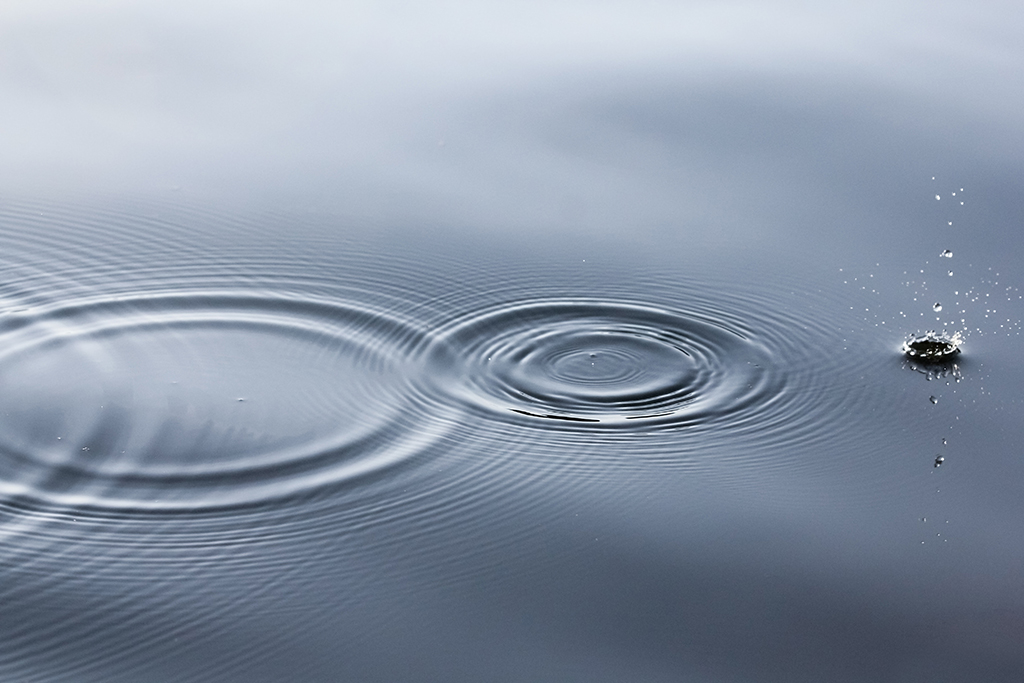
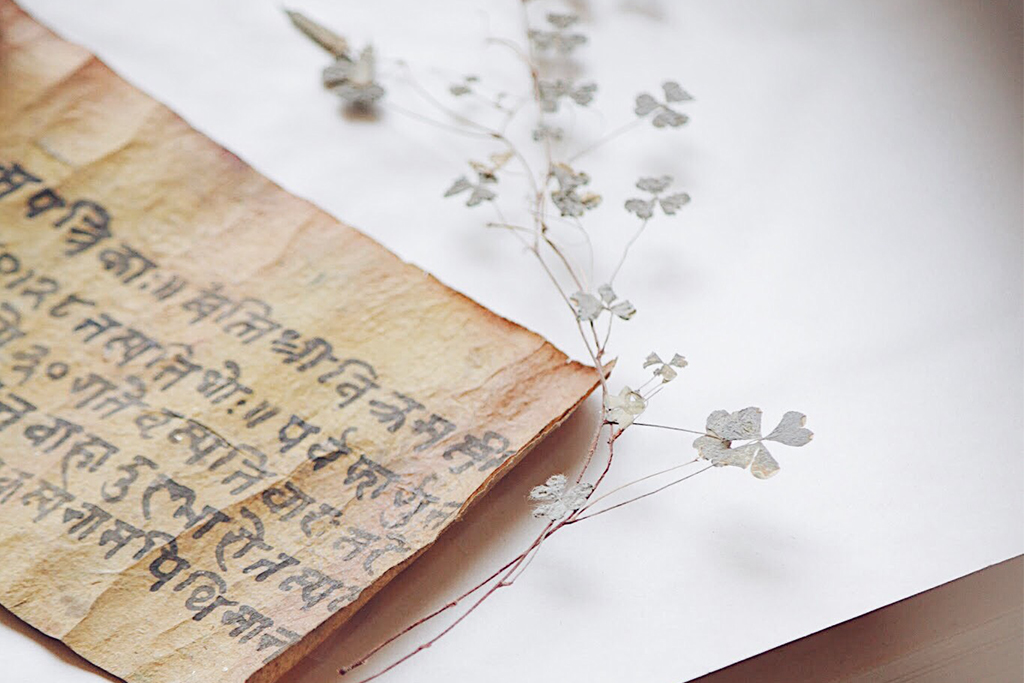


Yoga mudras offer one of the easiest routes to wellbeing. They can be combined with pranayama and Yoga practice or performed individually almost anywhere and at any time. When practised daily, Yoga mudras can help you deal with everyday lifestyle issues and improve wellbeing - physical, mental and spiritual

In the Vedic understanding of the human body, it is believed that our prana (life force) flows through the nadis (energy channels) in our body. There are said to be 72,000 nadis in our body, of which three – Ida, Pingala and Sushumna – are the most dominant. Ida flows through the left side of the spine while Pingala flows through the right side of the spine. And when both these nadis are purified and balanced, Sushumna flows through the center of the spine, enhancing the wellbeing of our body, mind and spirit. Our prana flows through these nadis within our body and from our body it is dispersed into the external world. In Yoga practice mudras are used to redirect our prana within the body, preventing our life force from being dissipated into the world.
Mudra comes from the Sanskrit word ‘mudr’ which means ‘joyous or glad’. But mudra has many different meanings. It is used to denote a ‘seal’ or ‘mark’ but is also used often to signify hand gestures often combined with asanas or pranayama in Yoga to seal our energy into specific nadis and heal and stabilise the body and mind from within.
Namaste is perhaps the most common mudra many of us practise on a daily basis. It is also known as Anjali mudra. Both the hands are joined together, pressed firmly against each other, with the fingertips pointing upwards. This mudra is performed while praying and traditionally used as a greeting or salutation in India. Namaste is a symbol of honouring ourselves and the other. It is seen as a joining of the right and left hemisphere of the brain, signifying unity.
Several ancient texts mention mudras and their different uses. In his book Natyashastra Bharata Muni talks about mudras used in dance and drama. In Gheranda Samhita, one of the three classic texts on Hatha Yoga, 25 mudras are mentioned. According to this text mudras should be practised before pranayama to bring a pleasurable sensation that will aid the practice of pranayama. However, in Hatha Yoga Pradipika, another one of the three classic texts on Hatha Yoga, 10 mudras are mentioned and it is recommended that these mudras be practised after pranayama. Interestingly, Hatha Yoga Pradipika says that mudras cannot be practised by devas but only by humans since humans are constantly trying to attain a state of enlightenment.
Scientists and researchers are also increasingly studying Yoga mudras and their benefits to both, the body and mind. In a recent study, heart patients were asked to perform a Yoga mudra which the study refers to as ‘V mudra’. Within 15 minutes a significant positive change was visible. In fact, this study goes on to recommend ‘V mudra’ as a possible emergency mudra for heart patients during a heart attack. The mudra they used is the Apan Vayu mudra – known as the lifesaver in classical Indian texts. The index finger is bent to touch the base of the thumb and the tip of the thumb is joined by the tip of the middle finger and ring finger as the little finger is extended outwards. This mudra strengthens the heart and regulates heart-related complications.
The classical texts that describe these mudras attribute to each certain physical, mental, emotional or spiritual benefit. As in the case of the Apan Vayu mudra, science has validated the earlier claim. In our rushed and harried lives, mudras might offer one of the easiest routes to a semblance of wellbeing – physically, emotionally and mentally. The biggest advantage is that most mudras can be practised with ease and at our convenience. However, the few restrictions or contraindications that the texts prescribe should be adhered to.
Here are five Yoga mudras that, when practised consistently, can improve your wellbeing.
Jnana Mudra: This mudra is also known as the consciousness mudra. It is practised often during pranayama or Yoga asanas. Rest your hands gently on the thighs, palms facing upwards. Join the thumb and the index finger and let the rest of the fingers extend outwards. Gertrud Hirschi explains in her book Yoga in your Hands that the Jnana mudra is the ultimate symbol of cosmic consciousness. The thumb is a symbol of the cosmos, the index finger is a symbol of the individual and the remaining fingers represent the three gunas – Tamas, Sattva and Rajas. With this gesture, by joining the index finger and the thumb, one expresses the desire to unify the Atman or human consciousness with Brahman or cosmos. This mudra is also believed to calm the mind and uplift mood.
Ushas Mudra: If you have difficulty waking up in the morning Ushas mudra is ideal for you. Perform this mudra while still in your bed to energise your mind and body. Clasp your fingers together so that the right thumb is between the left thumb and the index finger (men should place the right thumb over the left thumb). Now place the clasped hands at the back of your head or extend your arms above your head (depending on what works best for you). Inhale vigorously, opening and closing your mouth and eyes several times. This mudra should be practised 6 times for 5-15 minutes every morning.
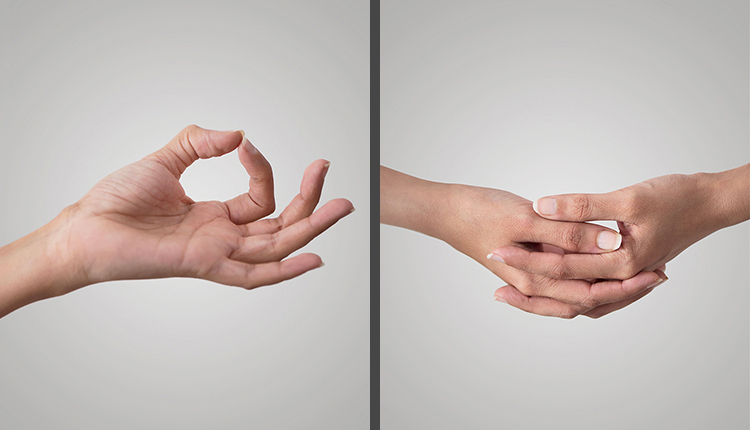
Jnana mudra on the left is a well-known mudra. On the right is Ushas mudra, ideal in the morning.
Pushan Mudra: This mudra is dedicated to the Sun god who is also believed to be the god of nourishment. For your right hand – bring the tip of your thumb, index finger and middle finger together and extend the other fingers outwards. For your left hand – bring the tip of your thumb, ring finger and middle finger together and extend the other fingers outwards. Pushan mudra is a symbol of receiving and giving. The right hand symbolizes receiving and the left hand symbolizes giving back or letting go. Physically, this mudra impacts your digestion cycle – absorbing food and eliminating waste. It also helps absorb oxygen and release carbon dioxide and has a relaxing impact on the solar plexus. This mudra can be practised for 5 minutes, four times a day or as an immediate help.
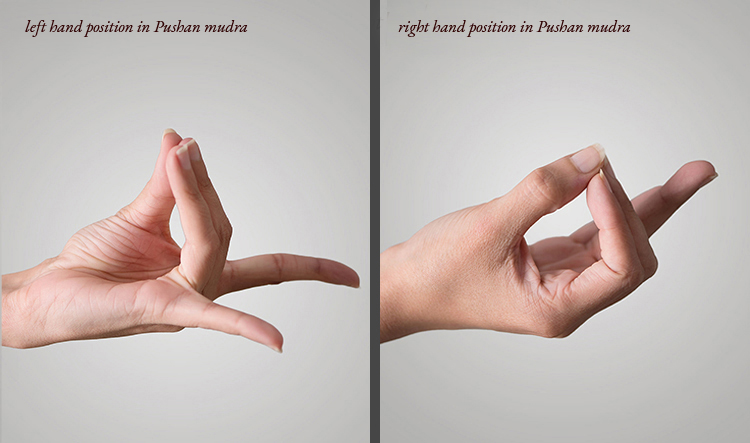
In Pushan mudra, unlike other mudras, both hand positions are different.
Prithivi Mudra: Join the tip of the thumb with the tip of the ring finger of both your hands, extending the other fingers outwards. The Prithivi Mudra focusses on the root chakra, energising the body, bringing inner stability and self-assurance. It is also believed to be good for your skin, hair, nails and sense of smell. It can be practised for 15 minutes, three times a day or as needed.
Kundalini Mudra: This mudra is associated with the awakening of sexual force. Form a loose fist with both your hands, extend the index finger of your left hand and insert it into the right fist from below resting the right thumb on top of the finger. Hold this mudra near your abdomen for 15 minutes until the desired effect occurs or practise it three times a day. Kundalini mudra signifies both the joining of the masculine force with the feminine force, and the unification of the individual with the cosmos.
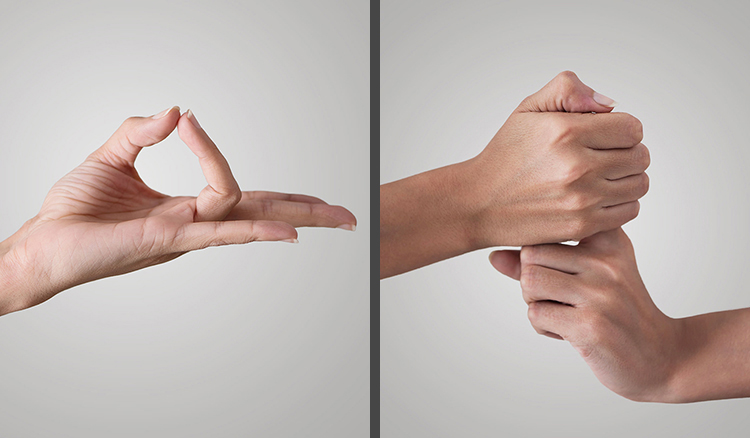
Prithivi mudra, on the left, energises the body. On the right is the Kundalini mudra.
These mudras can be practised while commuting to work, sitting at your desk or lying in your bed at the end of the day. Including mudras in your daily Yoga practice or as a part of your unwinding routine can be highly beneficial. Especially when practised mindfully and on a daily basis, they can help improve sleep patterns, digestive issues, energise your body and enhance your overall physical and mental wellbeing.
Thank you for this information. It’s really helpful for me.
Thanks so much for sharing your knowledge. I knew some of the Mudras but you explained well! I appreciate. Thanks again! Peace and joy to you and your family!